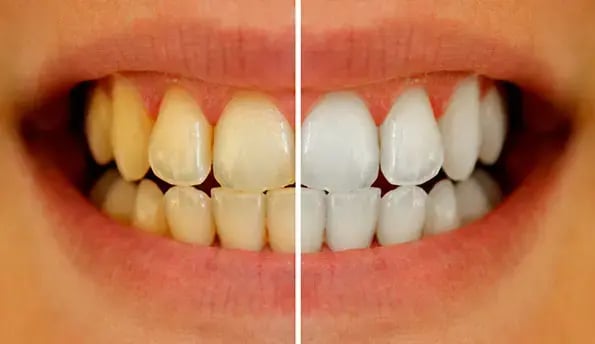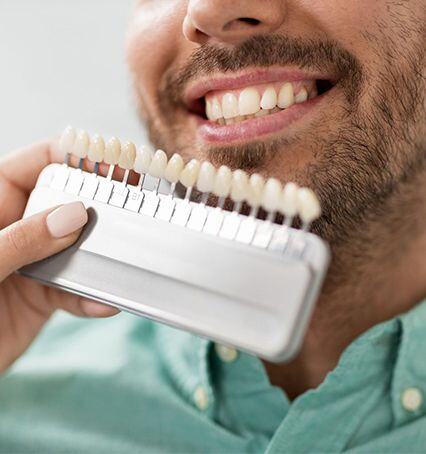What is Tooth Discoloration?
Understanding the Causes and Treatments of Tooth Discoloration
Tooth discoloration refers to any change in the color of the teeth that deviates from the natural white or off-white shade. It can manifest as stains, spots, or a yellow, brown, or grayish hue on the teeth. Tooth discoloration can occur on the outer surface of the tooth enamel or within the tooth structure itself.
There are two main types of tooth discoloration:
1. Extrinsic Tooth Discoloration: This type of discoloration affects the outer layer of the tooth enamel. It is usually caused by external factors such as:- Foods and beverages: Certain foods and drinks like coffee, tea, red wine, berries, and highly pigmented foods can stain the teeth over time.
- Tobacco use: Both smoking and chewing tobacco can lead to yellow or brown stains on the teeth.
- Poor oral hygiene: Inadequate brushing and flossing can allow plaque and tartar buildup, leading to tooth discoloration.
- Medications: Some medications, such as certain antibiotics (e.g., tetracycline) taken during tooth development or antihistamines, can cause tooth stains.
- Mouthwashes and rinses: Certain mouthwashes containing chlorhexidine or cetylpyridinium chloride can cause tooth discoloration with prolonged use.
- Tooth trauma: A blow to the mouth or injury to a developing tooth can cause internal bleeding, leading to discoloration.
- Tooth decay: Deep dental caries or infections can result in tooth discoloration, usually appearing as brown or black spots.
- Aging: As we age, the enamel naturally wears down, revealing the yellowish dentin layer underneath, making the teeth appear discolored.
- Genetic factors: Some individuals may have naturally darker or more yellowish teeth due to their genetics.
- Excessive fluoride: Consuming high fluoride levels during tooth development (fluorosis) can cause white or brownish discoloration.
Our mission is to create a world where every investment in modern beauty is Worth It.
Let's keep in touch
Get updates of the treatments you are interested
What Causes Yellow Teeth?

How To Improve Yellow Teeth?
There are several ways to improve the appearance of yellow teeth:
1. Practice good oral hygiene: Brush your teeth at least twice daily and floss daily to remove plaque and prevent staining.
2. Use whitening toothpaste: Choose a toothpaste that contains whitening agents to help remove surface stains and brighten the teeth.
3. Avoid staining substances: Limit your consumption of foods and beverages that stain teeth, or rinse your mouth with water afterward to minimize their impact.
4. Quit smoking: If you smoke, quitting can help prevent further yellowing of the teeth and improve your overall oral health.
5. Professional teeth whitening: Consider visiting a dentist for professional teeth whitening treatments. They can use more potent whitening agents and techniques to lighten the color of your teeth effectively.

How To Get Rid Of Yellow Teeth?
It's important to note that not all types of tooth discoloration can be entirely eliminated or improved. In some cases, intrinsic stains or tooth discoloration caused by certain medications or dental conditions may require alternative cosmetic treatments, such as dental veneers or crowns, to achieve the desired results. Consulting with a dentist will provide personalized advice based on your situation.
If you're looking to get rid of yellow teeth and achieve a brighter smile, there are several methods you can try. Here are some options:
Practice good oral hygiene: Brush your teeth at least twice daily using fluoride toothpaste and a soft-bristle toothbrush. Floss daily to remove plaque and debris from between your teeth.
Avoid stain-causing foods and drinks: Limit your consumption of foods and beverages that can stain your teeth, such as coffee, tea, red wine, berries, and colored sodas. If you do consume them, rinse your mouth with water afterward.
Use whitening toothpaste: Look for toothpaste containing whitening agents or mild abrasives to help remove surface stains. However, remember that whitening toothpaste can only lighten the color of your teeth slightly.
Try whitening strips or trays: Over-the-counter whitening strips or trays can effectively reduce yellow stains. Follow the instructions carefully and use them as directed.
Professional teeth whitening: Consider visiting a dentist for professional teeth whitening. They can use more potent bleaching agents and customize the treatment to your needs. This method is more effective and can provide significant results.
Oil pulling: This ancient practice involves swishing oil (such as coconut oil) in your mouth for 15-20 minutes, then spitting it out. Some people claim it helps whiten teeth, although scientific evidence is limited.
Quit smoking: Smoking tobacco products can cause severe tooth discoloration. Quitting smoking can prevent further yellowing and improve your overall oral health.
Maintain a healthy diet: Consume crunchy fruits and vegetables like apples, carrots, and celery. They can help remove surface stains and promote saliva production, which aids in neutralizing acids and protecting your teeth.
Visit your dentist regularly: Regular dental cleanings and check-ups are essential for maintaining good oral health. A dentist can remove plaque, tartar, and surface stains that regular brushing cannot eliminate.
It's important to note that teeth naturally vary in shade, and achieving a "Hollywood white" may not be realistic or suitable for everyone. It's always best to consult a dentist to determine the best approach for your situation and ensure your teeth and gums remain healthy.
Our mission is to create a world where every investment in modern beauty is Worth It.
Let's keep in touch
Get updates of the treatments you are interested
Understanding the Causes and Treatments of Tooth Discoloration
Tooth discoloration refers to any change in the color of the teeth that deviates from the natural white or off-white shade. It can manifest as stains, spots, or a yellow, brown, or grayish hue on the teeth. Tooth discoloration can occur on the outer surface of the tooth enamel or within the tooth structure itself.
There are two main types of tooth discoloration:
1. Extrinsic Tooth Discoloration: This type of discoloration affects the outer layer of the tooth enamel. It is usually caused by external factors such as:- Foods and beverages: Certain foods and drinks like coffee, tea, red wine, berries, and highly pigmented foods can stain the teeth over time.
- Tobacco use: Both smoking and chewing tobacco can lead to yellow or brown stains on the teeth.
- Poor oral hygiene: Inadequate brushing and flossing can allow plaque and tartar buildup, leading to tooth discoloration.
- Medications: Some medications, such as certain antibiotics (e.g., tetracycline) taken during tooth development or antihistamines, can cause tooth stains.
- Mouthwashes and rinses: Certain mouthwashes containing chlorhexidine or cetylpyridinium chloride can cause tooth discoloration with prolonged use.
- Tooth trauma: A blow to the mouth or injury to a developing tooth can cause internal bleeding, leading to discoloration.
- Tooth decay: Deep dental caries or infections can result in tooth discoloration, usually appearing as brown or black spots.
- Aging: As we age, the enamel naturally wears down, revealing the yellowish dentin layer underneath, making the teeth appear discolored.
- Genetic factors: Some individuals may have naturally darker or more yellowish teeth due to their genetics.
- Excessive fluoride: Consuming high fluoride levels during tooth development (fluorosis) can cause white or brownish discoloration.
Our mission is to create a world where every investment in modern beauty is Worth It.
Let's keep in touch
Get updates of the treatments you are interested
What Causes Yellow Teeth?

How To Improve Yellow Teeth?
There are several ways to improve the appearance of yellow teeth:
1. Practice good oral hygiene: Brush your teeth at least twice daily and floss daily to remove plaque and prevent staining.
2. Use whitening toothpaste: Choose a toothpaste that contains whitening agents to help remove surface stains and brighten the teeth.
3. Avoid staining substances: Limit your consumption of foods and beverages that stain teeth, or rinse your mouth with water afterward to minimize their impact.
4. Quit smoking: If you smoke, quitting can help prevent further yellowing of the teeth and improve your overall oral health.
5. Professional teeth whitening: Consider visiting a dentist for professional teeth whitening treatments. They can use more potent whitening agents and techniques to lighten the color of your teeth effectively.

How To Get Rid Of Yellow Teeth?
It's important to note that not all types of tooth discoloration can be entirely eliminated or improved. In some cases, intrinsic stains or tooth discoloration caused by certain medications or dental conditions may require alternative cosmetic treatments, such as dental veneers or crowns, to achieve the desired results. Consulting with a dentist will provide personalized advice based on your situation.
If you're looking to get rid of yellow teeth and achieve a brighter smile, there are several methods you can try. Here are some options:
Practice good oral hygiene: Brush your teeth at least twice daily using fluoride toothpaste and a soft-bristle toothbrush. Floss daily to remove plaque and debris from between your teeth.
Avoid stain-causing foods and drinks: Limit your consumption of foods and beverages that can stain your teeth, such as coffee, tea, red wine, berries, and colored sodas. If you do consume them, rinse your mouth with water afterward.
Use whitening toothpaste: Look for toothpaste containing whitening agents or mild abrasives to help remove surface stains. However, remember that whitening toothpaste can only lighten the color of your teeth slightly.
Try whitening strips or trays: Over-the-counter whitening strips or trays can effectively reduce yellow stains. Follow the instructions carefully and use them as directed.
Professional teeth whitening: Consider visiting a dentist for professional teeth whitening. They can use more potent bleaching agents and customize the treatment to your needs. This method is more effective and can provide significant results.
Oil pulling: This ancient practice involves swishing oil (such as coconut oil) in your mouth for 15-20 minutes, then spitting it out. Some people claim it helps whiten teeth, although scientific evidence is limited.
Quit smoking: Smoking tobacco products can cause severe tooth discoloration. Quitting smoking can prevent further yellowing and improve your overall oral health.
Maintain a healthy diet: Consume crunchy fruits and vegetables like apples, carrots, and celery. They can help remove surface stains and promote saliva production, which aids in neutralizing acids and protecting your teeth.
Visit your dentist regularly: Regular dental cleanings and check-ups are essential for maintaining good oral health. A dentist can remove plaque, tartar, and surface stains that regular brushing cannot eliminate.
It's important to note that teeth naturally vary in shade, and achieving a "Hollywood white" may not be realistic or suitable for everyone. It's always best to consult a dentist to determine the best approach for your situation and ensure your teeth and gums remain healthy.






